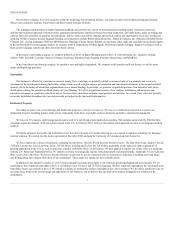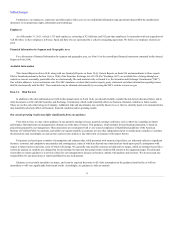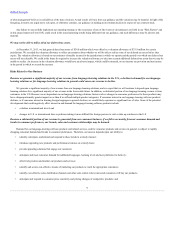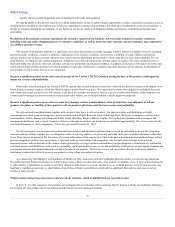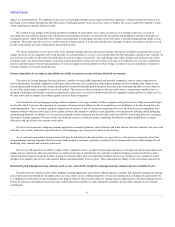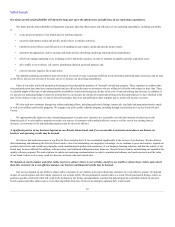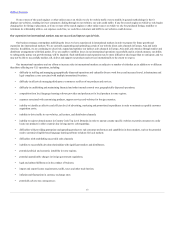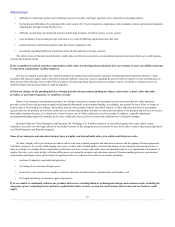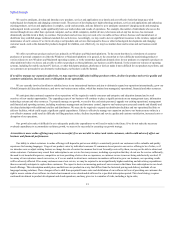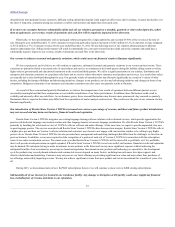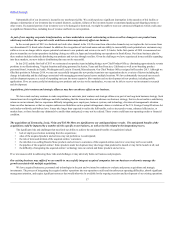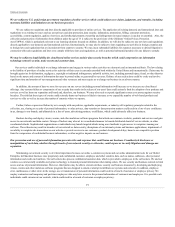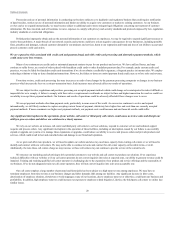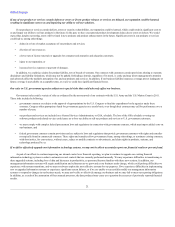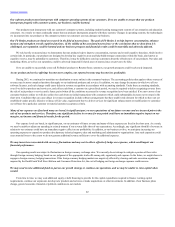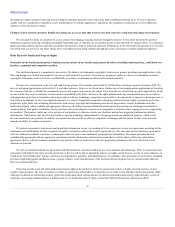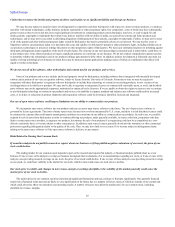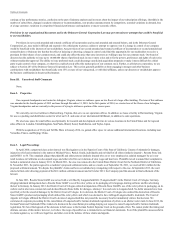Rosetta Stone 2013 Annual Report Download - page 18
Download and view the complete annual report
Please find page 18 of the 2013 Rosetta Stone annual report below. You can navigate through the pages in the report by either clicking on the pages listed below, or by using the keyword search tool below to find specific information within the annual report.
Table of Contents
Substantially all of our inventory is located in one warehouse facility. We could experience significant interruption in the operation of this facility or
damage or destruction of our inventory due to natural disasters, accidents, failures of the inventory locator or automated packing and shipping systems or
other events. If a material portion of our inventory were to be damaged or destroyed, we might be unable to meet our contractual obligations which could cause
us significant financial loss, including loss of revenue and harm to our reputation.
As part of our ongoing corporate transformation, we have undertaken several restructuring actions as well as changes to our product team
which may not deliver the expected results and these actions may adversely affect our business.
In the second quarter of 2013 we shuttered our kiosk sales channel in the U.S. Revenue from other sales channels may not replace the lost revenue from
our discontinued U.S. kiosk sales channel. In addition, the recognition of our brand name and our ability to successfully reach potential new customers may
suffer as we are no longer able to expose potential customers to our products and services via our U.S. kiosks. In the first quarter of 2014 we announced our
plan to streamline our Asian operations including closing our office in Japan and streamlining our operations in South Korea. Our future business plan for
these markets includes indirectly distributing our products and services through resellers. Given the challenges we have experienced in successfully expanding
into these markets, our new indirect distribution plan may not be successful.
In late 2012 and the first half of 2013 we restructured our product team including hiring a new Chief Product Officer, eliminating approximately seventy
positions in our Harrisonburg, Virginia location and hiring personnel in Austin, Texas and San Francisco, California as well as on-boarding product
personnel from Livemocha in Seattle, Washington and Lexia in Concord, Massachusetts. Our Chief Product Officer resigned in December 2013. Although we
filled this position in February 2014, we may not successfully integrate the new product team into our organization due to a variety of factors including the
change in leadership and the challenges associated with managing personnel spread across multiple locations. We have substantially increased our research
and development expense as a result of expanding our team into more expensive labor markets and our development of new products, including mobile
applications. If we are unsuccessful in introducing new products and services to the marketplace, we may not be able to recover our investment in research
and development.
Acquisitions, joint ventures and strategic alliances may have an adverse effect on our business.
We have made and may continue to make acquisitions or enter into joint ventures and strategic alliances as part of our long-term business strategy. Such
transactions involve significant challenges and risks including that the transaction does not advance our business strategy, that we do not realize a satisfactory
return on our investment, that we experience difficulty integrating new employees, business systems, and technology, diversion of management's attention
from our other businesses or that we acquire undiscovered liabilities such as patent infringement claims or violations of the U.S. Foreign Corrupt Practices Act
and similar worldwide anti-bribery laws. It may take longer than expected to realize the full benefits, such as increased revenue, enhanced efficiencies, or
market share, or those benefits may ultimately be smaller than anticipated, or may not be realized. These events could harm our operating results or financial
condition.
The acquisitions of Livemocha, Lexia, Vivity and Tell Me More are significant to our anticipated future results. The anticipated benefits of the
acquisitions could be impacted by a number of risks specific to our business, as well as by risks related to the integration process.
The significant risks and challenges that may limit our ability to achieve the anticipated benefits of acquisitions include:
•lack of employee retention stemming from the acquisitions;
•sales of the acquired products and services may not perform as we anticipated;
•the risk of increased attrition of the acquired entities’ customers;
•the risk that cross-selling Rosetta Stone products and services to customers of the acquired entities (and vice versa) may not be successful;
•the pipeline of the acquired entities’ future products under development may take longer than predicted to launch or may fail to launch at all; and
•the difficulty of integrating the acquired entities’ technology into our current and future products and services.
If we are unsuccessful in addressing these risks and challenges it may adversely harm our business and prospects.
Our existing business may suffer if we are unable to successfully integrate acquired companies into our business or otherwise manage the
growth associated with multiple acquisitions.
We have acquired businesses, personnel and technologies in the past and we intend to continue to evaluate and pursue acquisitions and strategic
investments. The process of integrating the acquired entities' operations into our operations could result in unforeseen operating difficulties, absorb significant
management attention, and require significant resources that would otherwise be available for the ongoing execution and development of our existing operations.
17


